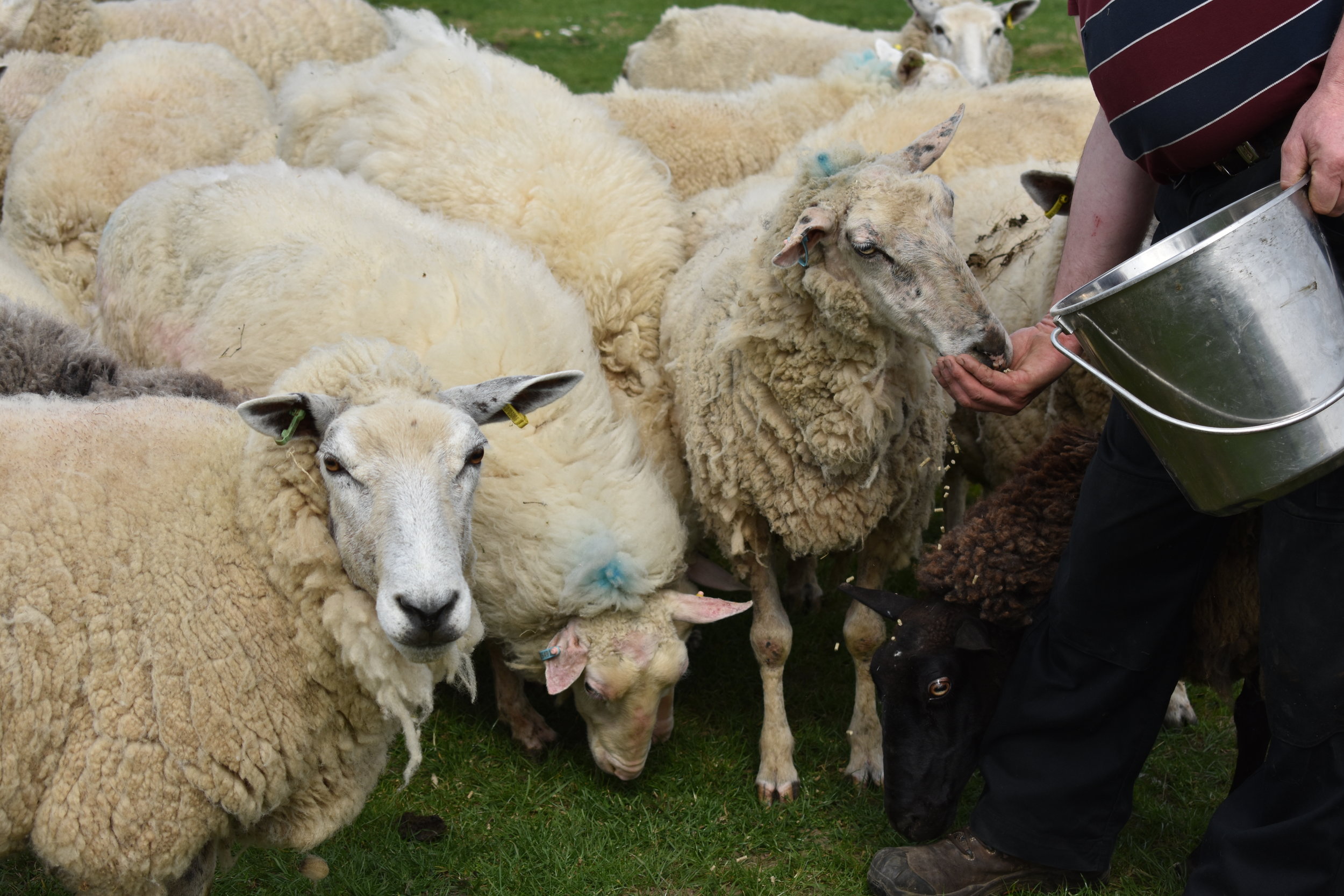PROFILE: Alan Jones at Derwen Gam, May 2019
When February comes around I pick up the phone and call Alan Jones. It is getting close to lambing season. But it isn’t for the lamb I am getting in touch.
Alan Jones is an organic farmer on the Lleyn peninsula near Pwllheli, North Wales. On his farm Derwen Gam (Crooked Oak) he breeds Lleyn sheep to produce a rich and satisfying milk. He has worked with sheep for three years now. His flock is 200 strong, 120 of which are used in the production of milk.
Lleyn are a native breed to this particular peninsula near the Snowdonia National Park. They were also originally found in parts of Ireland. In the 1970’s the population of these sheep dropped to around 7,000 but has since enjoyed a steady growth, especially in parts of Yorkshire and Lancashire. This is due to the characteristics of the ewe, a prolific breeder, with a quiet temperament that yields high levels of milk for her offspring. They produce a healthy quantity of milk feeding purely on grassy pastures and this is exactly why Alan spends the majority of his time researching and implementing a strict herbal ley system. His use of herbal leys is integral to the health of his flock and the flavour of their milk, and why I wanted to visit him.
A herbal ley is a complex mixture of grasses, herbs and legumes that is maintained through animal grazing. Its benefits to the soil, wildlife and livestock are innumerable. Frank Newman Turner, a pioneer in this field, described these pastures as his “manure merchant, food manufacturer and vet all in one”.
Alan’s reasons for utilising this system are that it saves money and time whilst providing his flock with exactly what they need when they need it. We should understand that the choices of farmers to follow organic principles and traditional methods must, primarily, come down to good business. Alan actually turned from breeding cattle to sheep when the foot and mouth crisis hit hard, ruining thousands of farms up and down the isles, Alan’s included. The plan made good business sense, after all farmers must first make a living to sustain their families and livelihoods. This is why many farmers, in the first place, will turn to fertilisers and antibiotics to maintain steady growth of their crops and livestock and pesticides and fungicides to suppress weeds, pests and other unwanted troubles that will kill off their crop.
These farmers were given tools to ensure their crop would be successful year after year with minimum maintenance and work. The poisons that now leach into our soils, rivers and our bodies were offered to make sure the farmer would not go bankrupt, that he could feed his children, cut out the strain of long days and nights and prosper against the supposed opposition of nature. Unfortunately this has given control to the agri chemical companies and made big business out of intensive farming. These options, for an uncertain farmer are understandable on personal terms but there has always been other options, more traditional methods available, that require a little more planning and a firm understanding and working with nature. We needn’t use the modern labels of ‘organic’ or ‘bio dynamic’ but rather simply observe these principles for their sound ethical reasoning to both the land, the economy and our own bodies.
Alan’s organic herbal leys are a wonder to behold. The bright colours attractive, the smells sweet and aromatic, underfoot it is soft and springy. It is easy to maintain, only taking a simple rotational system of grazing to keep short and it proves enormously cost efficient. That’s because the various herbs are feeding the soil and the sheep all at once. And not just that but it is medicating both parties too.
Each type of grass, herb and legume that Alan plants plays a unique and integral role, which when combined create a delicate and balanced system of bio diversity that is harmonious to all concerned.
Grasses, which include westerworlds ryegrass, timothy, cocksfoot, meadow fescue, creeping red fescue, foxtail take on many applications in the overall picture. First, our climate here in the British Isles is ideal for grass growth, making it a cheap and abundant source of forage for livestock.
Westerworlds in particular is an extremely fast growing variety and along with its high sugar content is ideal for producing silage which will feed the animals throughout winter.
Cocksfoot has the deepest roots of the varieties which makes it ideal to facilitate drainage and offer lots of organic matter to thin soils. It is the earliest of the grasses to spring and grows back after grazing with vigour.
Red fescue tolerates drought as it forms dense turf making a good choice for surplus forage.
Legumes play an accompanying role, collecting nitrogen from the air and fixing it into the soil to aid the growth of plants and eliminating the need for artificial nitrogen fertilisers. Legumes are also high in protein and medicinal properties boosting animal welfare and performance. Included in Alan’s mix are white clover, red clover, crimson clover, sainfoin, sweet clover and vetches.
White clover is probably one the most valuable plants in any organic farmers arsenal. The stem that runs along the ground producing leaves and flowers at low levels make it perfect for grazing. It grows well in nitrogen deficient soil and adds carbon trapped from the sunlight back into the soil. As an integral part of the diet for the sheep it helps to cleanse the blood, aids digestion and balances cholesterol.
Sainfoin adds copious amounts of nitrogen to the soil eradicating the need for chemical fertilisers. It is also high in tannins which provide a high protein count to the feed. The tannins present also prevent bloat in the sheep. Its medicinal properties extend as a natural worming antidote for lambs as it has natural anthelmintic properties. It also helps to reduce the amount of methane produced by ruminants, invaluable from an environmental perspective. Just In this one plant we find various ailment preventatives eliminating the need for antibiotics whilst also helping to enrich the soil and keep the atmosphere clean.
Sweet clover Is a huge nitrogen fixer and produces huge quantities of green material for forage whilst vetches out compete weeds and improve soil structure.
Herbs have deep rooting systems which aerate the soil - tractors and their high diesel consumption are left at the wayside. The herbs are abundant with micro nutrients and minerals, adding a high nutrient content to the diet and remarkably, or maybe not so remarkably, these nutrients end up in our milk adding nutrient to our bodies.
Herbs in the mix include chicory, rib grass, yarrow and burnet. Alan loves chicory. We set about on his springy pastures, heads bent to the ground as he points out each grass, legume and herb and tell us each benefit. The chicory was yet to burst into season but he was determined to find a sample that he could show off.
It is deep rooted and will grow in heavy drought periods. It is high yielding, rich in mineral and also has anthelmintic properties which prevent intestinal parasites in the animals. Ribgrass is another nutritous plant, specifically containing large amounts of copper, calcium and selenium.
Yarrow is rich in vitamin A. This is interesting in sheep as unlike cows they do not transform vitamin A into carotene which is what turns cows milk butter yellow and why Sheeps milk butter (rare as it is) stays white.
Striding through these grasses and herbs I just couldn’t work out why anyone would farm any other way. Alan told me that many of his neighbours laughed at his rotation system whereby Alan herds the sheep twice a day to different meadows. The sheep will clip the grass from the tops when it has grown to just under a foot, leaving the last few leaves which allows the plants to catch sunlight to propel growth. This will take anywhere from up to three days to a week, weather dependent, after which the sheep will be put back onto the meadow to enjoy the flavours, nutrients and medicines at their most optimum.
Alan enjoys the time outdoors and as the meadows only need replenishing with new seed every three years or so he cuts out time weeding, ploughing and fertilising and, most importantly for a small hold farmer saves money on machinery, chemical fertilisers and diesel.
In this scenario everyone seems to win. Alan spends time outdoors, roaming the fields with his flock, surrounded by nature. The sheep enjoy a diet high in nutrient and are served medically by the wondrous plants. The land is thick with vegetation making a veritable habitat for insects, birds and other wildlife whilst replenishing the soils and cleaning the air around. And we at the other end of the chain receive a milk that is so thick and creamy, flavoursome and packed with vitamins and minerals.
The sheep themselves are testament to the benefits of the system. As Alan tells me, when he started out sowing herbal ley he only laid one field. When it came time to move the sheep to a new pasture they instinctively went to the herbal ley every time.
The ewes are milked twice a day at 6am and 6pm. Walking up a gantry tempted by a little feed Alan secures their heads and attaches a pump to their teets. This way he can milk two Sheep at a time. Afterwards their teets are wiped with an organic wood wool that keeps the sheep clean and prevents infection without using unnecessary chemicals.
In lambing season the lambs are left with their mother for up to 6 weeks and then weened off and after this fed by bottle. A lamb can drink 1.5 litres a day and a Ewe can produce 3 litres a day so there is plenty for the lamb to drink and for Alan to collect. Later when the lamb needs a larger amount of milk a substitute powder is mixed with left over whey from Carrie’s cheese making process.
The sheep will milk for 7 - 8 months between March and November. At the beginning of this season the milk was 3.1 % cream content, in April it went up to 5.9% and last season ended with a 13% content. This is due to the pasture becoming richer through the summer months. Extra fields are planted with his mixture of herbs and grasses in order to make hay and silage containing a high variety of herbs for the winter months.
Alan’s milk is distributed to only three places. Cariad Bakery in Anglesey, Carrie Rimes of Cosyn Cymru who is a sheep cheese producer in Bethesda, and our lucky selves at Where the Light Gets In in Stockport. Here, it flows through the menu from yoghurt, curds and an ice cream garnished with the left over whey in the form of a caramel.
There is of course a long waiting list for Alan’s milk, and we feel incredibly lucky and privileged to work with this product that all begins with what appears to be field full of grass.











